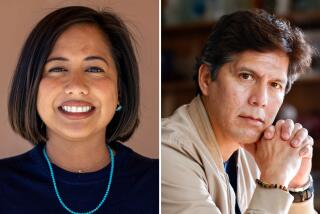Newton: Creating a Latino district
- Share via
There are two conversations going on inside the L.A. County Hall of Administration about the delicate matter of redrawing maps for the supervisorial districts. Both will come to a head Tuesday, but only one will be publicly acknowledged.
The surface conversation concerns the rising demographic significance of Latinos and the vague but consequential question of what constitutes “polarized voting.” One faction, led by Supervisor Gloria Molina, favors creating a second district that would include a majority of voting-age Latino citizens. Molina and her allies argue that creating such a district is a necessary next step in the political enfranchisement of Latino voters in Los Angeles. Without such a district, they say, Latinos are likely to continue to hold just one seat on the five-member Board of Supervisors, even though about one-third of the county’s voting-age citizens — and almost half of its residents — are Latino.
There are legal and political arguments on both sides of that debate. If there is “polarized voting” in Los Angeles County — meaning that Latinos are unable to elect candidates of their choosing because votes split along ethnic lines — the Voting Rights Act would direct the supervisors to create a district in which Latinos could band together effectively. But is that the case?
It’s naive to think that voters are race-blind or that black or white voters don’t sometimes gang up to thwart the ambitions of candidates favored by Latinos. In Compton, for instance, there is ample evidence that unified voting by blacks has kept Latinos from winning office, despite their large and growing numbers in the city. But it’s also true that Latinos have demonstrated significant ability to elect candidates they favor elsewhere in the county — witness Mayor Antonio Villaraigosa, Sheriff Lee Baca and even California’s new attorney general, Kamala Harris, a non-Latina who, running against Steve Cooley, carried Los Angeles County in part because of strong Latino support.
None of that is what will tip the outcome of the redistricting debate. For the five supervisors, the public conversation about the Voting Rights Act is only a piece of the picture. It’s also about politics.
Molina came to office in the wake of a legal challenge to the board’s district lines in 1990; she’s determined to create a second district in the model of her own, and she enjoys strong support from groups such as the Mexican American Legal Defense and Educational Fund.
Michael D. Antonovich is a conservative who’s never shown much interest in using redistricting to expand minority voting power; his district carves off the top of Los Angeles County, and he’s content to leave the lines just as they are.
Don Knabe draws his money from the area around Marina del Rey and the core of his political support from Cerritos and Diamond Bar; he’s determined to hold onto both, which he wouldn’t do under the Molina plan.
Mark Ridley-Thomas is in the precarious position of representing a district that is more than a third African American in a county where blacks make up just 11% of the voting-age population; he likes the idea of a new Latino district, so long as it doesn’t carve up his ethnic base.
That leaves Zev Yaroslavsky. Back to him in a moment.
The supervisors have three maps to choose from: One submitted by Knabe largely preserves the status quo; it has the backing of Knabe and Antonovich. Molina has submitted a map that pushes Yaroslavsky’s district south and cuts off the coastal part of his district to create the new Latino seat. Ridley-Thomas proposes a more modest version of what Molina has offered, but his version too would extend Yaroslavsky’s district south and east and lop off the coastal area from the Palisades up through Malibu. Molina and Ridley-Thomas prefer their own maps but prefer each other’s to Knabe’s. They could coalesce around a single proposal.
But here’s the rub: It requires four votes to approve any map, and so far, none has even three votes, much less four.
In one sense, that offers Yaroslavsky, who will be termed out of office in 2014, an opportunity: He’s considering a run for mayor, and one way to advance that ambition would be to join Ridley-Thomas and Molina, placating Latino groups while risking little because neither Knabe nor Antonovich would probably supply a fourth vote. He has adamantly refused to take that out, however, kicking off rounds of speculation about what he’s up to. Depending on who you ask, Yaroslavsky appears principled, stubborn, foolish or shrewd.
Yaroslavsky’s position can be viewed as a brave refusal to knuckle under to identity politics, but it’s just as plausibly a calculated move to set up his future. Voting for the Molina or even the Ridley-Thomas plan might please Latinos, but it risks antagonizing some leaders from the San Fernando Valley, which would be split up. Others who could be angered include environmentalists in the Palisades and Malibu whose district now would be centered in the less environmentally ardent Long Beach and Torrance; Asian Americans who complain that they’re being scattered around the county; and Orthodox Jews, who would be split into Districts 2, 3 and 4. Those are all constituencies Yaroslavsky would need in a run for mayor.
Latino voting strength is on the rise, and the forces that once sought to thwart it — including the county Board of Supervisors in the 1980s — have thankfully lost out. But as Yaroslavsky well knows, for the moment, this remains a coalition city and county. Any candidate would relish Latino support, but Latino support is, by itself, not enough. Not yet.
More to Read
Get the L.A. Times Politics newsletter
Deeply reported insights into legislation, politics and policy from Sacramento, Washington and beyond. In your inbox three times per week.
You may occasionally receive promotional content from the Los Angeles Times.











